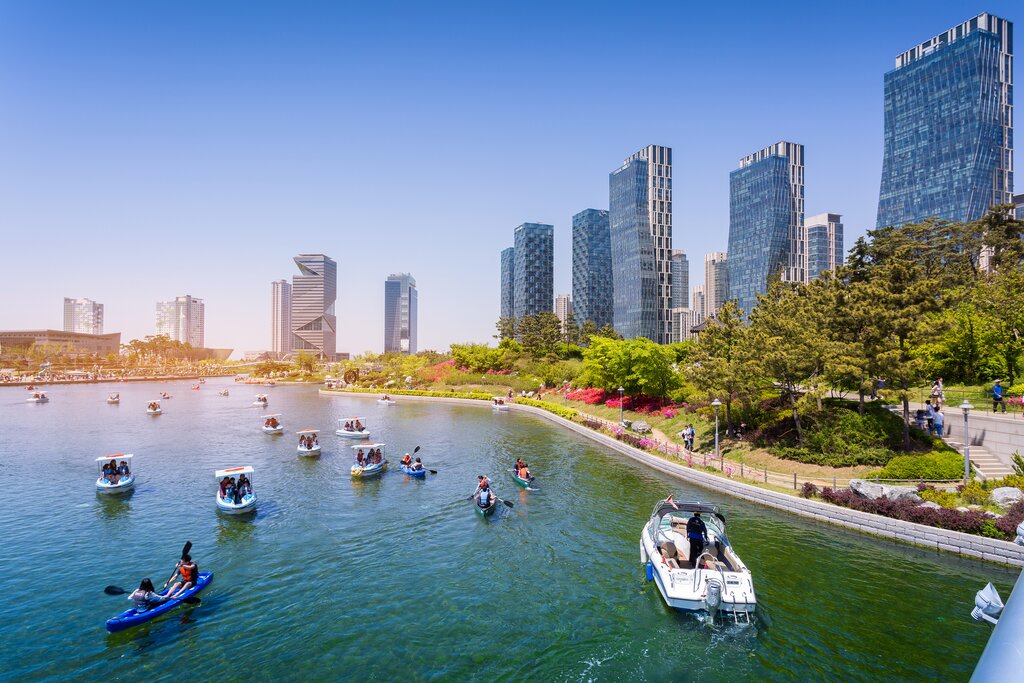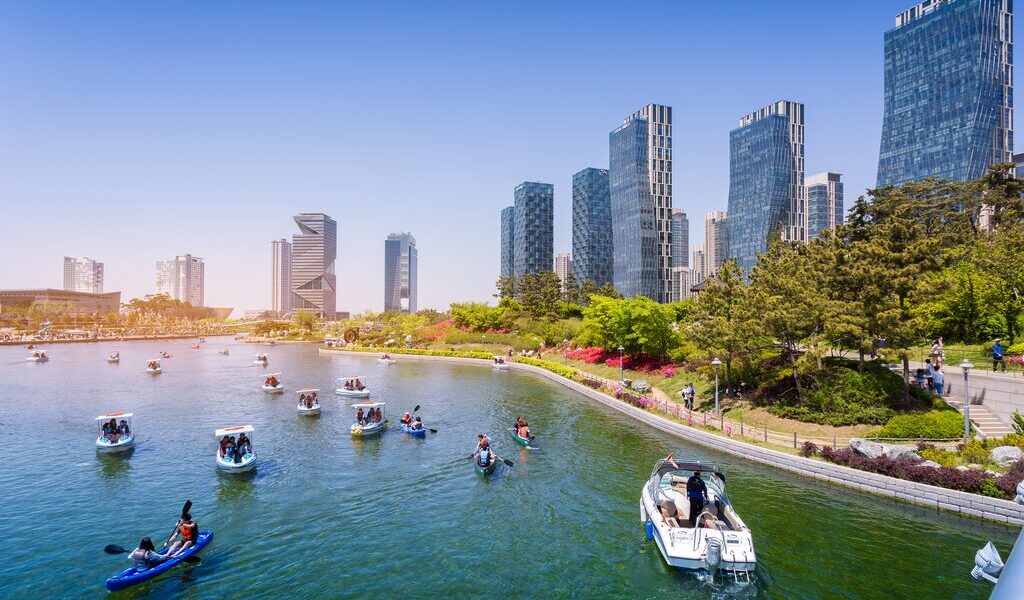
Summer begins in South Korea in June as temperatures and humidity levels climb. June also brings the start of the country’s monsoon season, with rainfall especially heavy along the southern coast. With crowds and prices low compared to the rest of the season, June offers the perfect opportunity to enjoy iconic summer activities like island hopping and beachgoing. Meanwhile, on rainy days, travelers can opt for indoor sightseeing or sample coffee and pastries at South Korea’s famous cafés.
## South Korea in June: A Comprehensive Travel Guide
June in South Korea heralds the arrival of summer, a season brimming with vibrant experiences and cultural festivities. While the heat begins to intensify, and the monsoon season makes its anticipated appearance, June offers a unique window of opportunity for travelers seeking a balance between pleasant weather, fewer crowds, and reasonable prices. It’s a time when the landscapes flourish, the cities buzz with energy, and a diverse array of activities awaits exploration.
**Weather in June: A Transition to Summer**
June signifies the transition from spring to summer in South Korea. The weather is characterized by rising temperatures and increasing humidity, although the extreme heat of July and August is yet to arrive. Expect warm days and mild evenings, with an average high temperature hovering around 79°F (26°C) and an average low of 61°F (16°C). This temperature range makes it ideal for outdoor pursuits and exploring the country’s diverse landscapes.
Humidity levels also begin to climb in June, reaching an average of 70%. While this may feel noticeable, it’s still more comfortable than the peak humidity experienced in July, which can soar as high as 90%. The combination of warmth and humidity creates a lush and verdant environment, enhancing the beauty of South Korea’s natural attractions.
One of the defining characteristics of June weather in South Korea is the onset of the annual monsoon season, locally known as *jangma*. This period of increased rainfall typically begins in late June and extends through July. While the early part of June tends to be predominantly sunny and dry, the likelihood of rain gradually increases as the month progresses. The transition is quite noticeable, with rainfall probabilities increasing by nearly 20% from the start to the end of the month.
It’s also worth noting that rainfall patterns can vary considerably depending on the geographical location within South Korea. The southern provinces, in particular, are more susceptible to experiencing heavier rainfall and, in rarer instances, the potential for typhoons. Travelers planning to visit coastal regions in the country’s south, such as the immensely popular vacation destination of **Jeju Island**, should pay close attention to weather forecasts and come well-prepared with appropriate rain gear, including waterproof jackets, umbrellas, and waterproof footwear. Being proactive about weather preparedness will ensure that unexpected downpours don’t dampen your travel experiences.
**Crowds and Costs: Balancing Popularity and Affordability**
June marks the beginning of the summer holiday season, which naturally leads to an increase in tourism across South Korea. Although South Korean students typically remain in school until July, the allure of summer travel often draws families from abroad to begin their vacations earlier. Consequently, popular tourist destinations and attractions experience a noticeable surge in visitors during June.
However, compared to the peak summer months of July and August, June generally remains the least crowded. Beaches, historical sites, and other points of interest are popular but not yet overwhelmingly congested. This makes June an excellent choice for travelers who prefer to avoid the intense crowds that characterize the later summer months.
Flight and hotel prices in June reflect this moderate level of demand. While prices are higher than during the shoulder seasons of spring and autumn, they remain relatively reasonable compared to the peak summer period. However, as the summer progresses and demand intensifies, costs are likely to rise. Therefore, it’s strongly advised that travelers planning a June trip book their flights and accommodations well in advance to secure the best possible rates and ensure availability, especially for popular destinations and sought-after hotels. Early booking is key to maximizing affordability and minimizing potential stress during your travel planning process.
**Where to Go in June: Exploring South Korea’s Diverse Landscapes**
South Korea offers a plethora of destinations to explore in June, catering to a wide range of interests and preferences. From bustling cities to serene islands, there’s something for every traveler to discover.
Begin your summer holiday in **Incheon**, a vibrant port city with a modern and international atmosphere. Spend sunny days leisurely meandering through **Songdo Central Park**, a sprawling green oasis in the heart of the city. Pack a delightful picnic lunch to enjoy in a shady spot, surrounded by lush greenery and tranquil scenery. Alternatively, take in the picturesque view from the water by indulging in a paddle boating or kayaking excursion along the river that winds through the park.
From Incheon, a short trip will take you to nearby **Seoul**, the dynamic capital city of South Korea. In Seoul, it’s incredibly easy to adjust your itinerary based on the ever-changing weather forecast. If the weather takes a turn for the worse, head to the **National Museum of Korea** to seek cover and immerse yourself in the country’s rich history and cultural heritage. The museum offers a vast collection of artifacts and exhibits that will keep you entertained for hours.
When the sun is shining brightly, take advantage of the opportunity to shop to your heart’s content in the bustling districts of **Myeongdong** and **Gangnam**. Myeongdong is renowned for its trendy fashion boutiques, cosmetics stores, and street food stalls, while Gangnam is famous for its high-end designer shops, entertainment venues, and upscale restaurants.
For a taste of traditional Korean culture, venture into the charming neighborhood of **Insadong**. Here, you can browse through quaint shops selling souvenirs, handicrafts, and traditional Korean artwork. Don’t miss the chance to visit a teahouse in Insadong and savor the delicate flavors of Korean tea in a serene and traditional setting.
As the sun gracefully sets and the temperatures begin to cool down, the city’s vibrant night markets beckon. **Gwangjang Market** is a must-visit destination, offering a delectable array of food and beverage offerings. From savory street snacks to traditional Korean dishes, you’ll find an abundance of culinary delights to tantalize your taste buds.
The **Seoul Capital Area** also serves as an ideal jumping-off point for island hopping adventures. With more than 70 inhabited and uninhabited islands located in Incheon, there’s a wealth of options to choose from. Plan a relaxing beach getaway to **Muuido Island**, where you can indulge in fresh seafood and comb the pristine beach for seashells during low tide.
**Jangbongdo Island** is known for its scenic hiking trails, offering breathtaking views of the coastline and surrounding islands. **Wolmido Island** is a perfect destination for families, featuring a popular boardwalk, an amusement park with thrilling rides, and a variety of entertainment options. With several islands located less than two hours from Seoul, visitors can easily plan a day trip or opt to stay overnight and fully immerse themselves in the island’s tranquil atmosphere. Adventurous travelers can even choose to spend a night camping beneath the starlit sky, creating an unforgettable experience.
**What to Do in June: Embracing Summer Activities**
The hot, sunny days of June are perfectly suited for classic summer activities, such as beachgoing. Take advantage of the lighter crowds at South Korea’s beautiful beaches before the peak summer tourist season begins in July. Active travelers can rent equipment for a variety of water sports, including windsurfing, standup paddleboarding, and sailing. For a more relaxing beach day, opt to soak up the sun with a refreshing drink in hand at one of the many beachside resorts, particularly in **Busan**, a coastal city renowned for its stunning beaches and vibrant nightlife.
If you’re visiting a major city, it’s wise to plan your visits to outdoor tourist attractions in the morning when crowds are smaller and temperatures are at their lowest. Indoor attractions, such as museums and art galleries, offer a welcome respite from the afternoon heat and provide shelter on rainy days.
South Korea is also famous for its fun and quirky cafés, which are especially popular during the summertime. Dotted across every major city, travelers can pop in between sightseeing to grab an iced coffee or treat themselves to *bingsu*, a sweet Korean shaved ice dessert topped with fruit or red bean – the perfect way to cool down and satisfy your sweet tooth.
Seoul is the host city for two major music festivals this month. Kick off the summer at the **World DJ Festival**, a three-day extravaganza where music lovers can dance alongside world-renowned DJs and nearly 100,000 other festivalgoers. Beat the heat at the **Waterbomb Festival**, highlighting the country’s top EDM and hip-hop artists. This exhilarating event, held at the end of the month, also features a swimming pool and equips the crowd with water guns, encouraging participants to engage in an epic water battle between sets. While the main festival takes place in Seoul, travelers staying in other cities, including **Busan** and **Daegu**, can participate in exciting offshoots.
**Events in June: A Celebration of Culture and Entertainment**
June in South Korea is a month filled with exciting events and festivals that showcase the country’s rich culture and vibrant entertainment scene.
**Waterbomb Festival, Seoul**: This is the largest music and water-themed festival in Korea, featuring electrifying EDM and hip-hop music performances and an unforgettable water gun battle. The main event occurs in Seoul, with exciting offshoots taking place in other major cities.
**Toechon Tomato Festival, Toechon**: This charming festival is hosted by a local tomato-producing village. It features a variety of tomato-themed events, including tomato picking, bathing in a tomato pool, and competing to build the tallest tomato tower.
**World DJ Festival, Seoul**: This world-renowned music festival in the capital city showcases a diverse range of music genres and DJs from around the globe.
**Hansan Ramie Fabric Cultural Festival, Seocheon**: This annual celebration of *ramie* fabric, a traditional Korean natural fiber produced in the Hansan-myeon region, is a showcase of Korean heritage. The event features a mesmerizing fashion show and an exquisite clothing display.
B-2318

